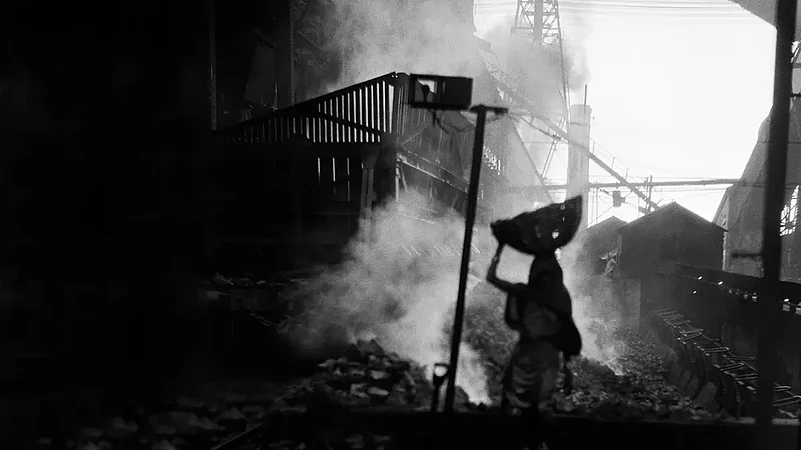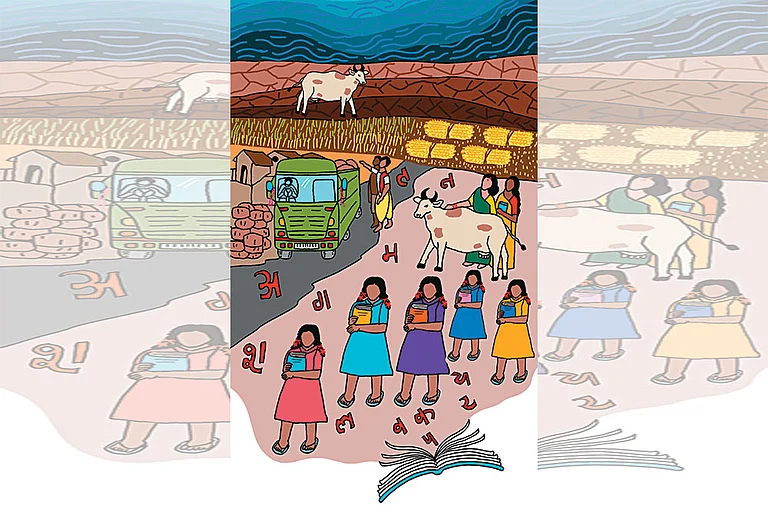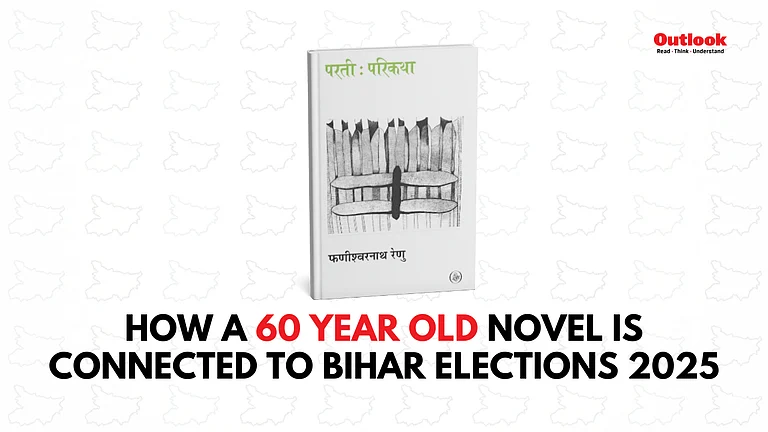Hazrat-e-īshā ko salīb par latkā diyā gayā hai,
ākhiri kīl thoki jā rhī hai, khat khat khat,
ye āwāz mere samāt se mushtaqil takrā rahī hai, khat khat khat.
mujhe radio ke liye talk likhnā hai, jiskā unvān hai qaumī yak-jehti,
maiñ apne pad par bas itnā hī likh pāyā hūñ,
qaumī yak-jehtī, khat khat khat
(Jesus has been hanged on the cross,
The last nail is being hammered with the sound khat, khat, khat
And the sound is continuously hitting my ears, khat, khat, khat
I have to write a talk for radio titled ‘Communal Solidarity’
And till now, I just wrote this on my Pad
Communal Solidarity, khat, khat, khat...)
This excerpt is all that survived of the story, ‘Qaumi Yak-jehti’ (Communal Solidarity), Zaki Anwar, a Gandhian worker and author of several Urdu novels and short stories, wrote on the night of April 10, 1979. Anwar, a professor at the Karim City College, Jamshedpur, was butchered by a rioting mob of Hindu fanatics the next day, a few hours after he recited the story to a small group of his kith and kin, claiming that it was his best work to date.
The murderous mob let loose a reign of terror and mayhem in the lanes and by-lanes of the steel city, set up by the House of the Tatas in the early 1900s, killing 108 innocent citizens, including women and children. Among the dead were 79 Muslims and 25 Hindus. In one of the most horrific incidents, an ambulance in Bhalubasa carrying women and children refugees was burnt by the rioters.
The late 1970s was a tumultuous time for the city of Jamshedpur. The Tata Steel plant, around which the city was built, had just emerged unscathed from the nationalisation attempts by the Morarji Desai-led Janata Party government at the Centre. On the other hand, Tata Steel also found itself battling the rising disaffection and consequent unrest among its contractual workers as it struggled to implement the casual labour guidelines set by the National Joint Consultative Committee for the Steel Industry.
In his semi-fictitious account of the city, Black Soil, labour leader Ali Amjad quotes poet B.Z. Maail as saying, “The only reason Jamshedpur had seen communal peace during the Partition years was that the Tata company had nothing to gain from Hindu–Muslim clashes."
The rising class consciousness among the steel city workers in the decades of the 1960s and 1970s could only be countered by communal tensions. Hence, the Jamshedpur riots of 1964 and 1979 were no surprise to political analysts. Ironically, it was the 1979 riots that led to the formation of the BJP in its present avatar.

JP along with Jagjivan Ram; Charan Singh; Raj Narain Photo: Getty Images
Madhukar Dattatraya Deoras, popularly known as Balasaheb Deoras, the then Rashtriya Swayamsevak Sangh (RSS) sarsanghchalak (chief), visited Jamshedpur in early April 1979 and allegedly instigated Hindus to claim their rights in a Hindu nation. Ten days later, the city went up in flames. The state government set up a three-member Commission of Enquiry to investigate the riots. Headed by Justice (retd.) Jitendra Narain, the commission established beyond doubt the involvement of Deoras and his outfit in the riots. “In the first instance, the speech of Shri Balasaheb tended to encourage the Hindu extremists to be unyielding in their demands regarding Road No. 14. Secondly, his speech amounted to communal propaganda. Thirdly, the shakhas and the camps that were held during the Divisional Conference presented a militant atmosphere to the Hindu public. In the circumstances, the Commission cannot but hold the RSS responsible for creating a climate for the disturbances that took place on the 11th of April, 1979 and thereafter,” stated the three-member commission in its 1981 report.
In one of the most horrific incidents, an ambulance in Bhalubasa carrying women and children refugees was burnt by the rioters.
Tensions started in the city when senior police officials in order to avoid communal conflagration prohibited various Ram Navami akhadas (sects) from performing the jhanda (flag) rallies, which had gained notoriety for provocative sloganeering, through the Muslim neighbourhoods in Road No. 14 of Mango, a densely populated ghetto. The commission further stated categorically, “The outbreak of the riots had been preceded by a series of aggressive acts committed by the Hindu communalists, led by the RSS, which had created an explosive situation.”
The city was then represented by Janata Party MLA Dinanath Pandey, who had strong ties with the RSS. It was perhaps this fact that boosted the confidence of the Sri Ram Navami Kendriya Akhada Samiti. In a pamphlet dated April 7, 1979, titled “Jamshedpur ki Dharma Premi Janata se Appeal (An Appeal to the Religious Public of Jamshedpur)”, the Samiti claimed that all policemen, including havildars, home guards and others, sympathised with them and would readily lend their support.
Apart from the RSS leaders, the Bihar Military Police (BMP) also allegedly played a negative role in the riots. Senior CPI leader Jagannath Sarkar, who visited the city after the riots, observed, “The role of the BMP stands out as a scandalous feature. There are many reports about its collusion in the riots. (Muslim) victims in refugee camps have complained. It is the ‘BMP’ that killed us, not the ‘Hindus’.”
The riots
The violence began on 11 April 1979 when the jhanda rallies used the pre-planned route through Road No. 14 in Mango, as the Samiti had ensured mass participation by asking all akhadas of Jamshedpur to join it. The rally turned into a murderous mob soon and executed the first major communal clash on the occasion of Ram Navami.
As this rally was about to begin, several panicked Muslims, who lived in Hindu-majority neighbourhoods, fled to save their lives. Anwar, true to his Gandhian principles, refused to move out. Three days ago, the Gandhian and some of his Hindu friends had initiated a satyagraha at the Gandhi Maidan in Mango. However, he was forced to abandon it after Muslim fundamentalists pelted stones at them. Interestingly, the same Muslim fundamentalists had gifted a golden pen from Mecca to Deoras after his incendiary speech.
Background and the aftermath
When the riots broke out in Jamshedpur, the Bihar government was led by Karpoori Thakur. Both Desai and Thakur were part of the Janata party, a broad coalition of anti-Congress parties from the left, right and centre of the political spectrum, born out of the anti-Emergency movement. It consisted of the Congress (O), from which Prime Minister Indira Gandhi and her supporters broke away in 1969, the Congress for Democracy formed by Jagjivan Ram, Hemvati Nandan Bahuguna and Nandini Satpathi, the Jan Sangh, which functioned as the political arm of the RSS, Chaudhary Charan Singh’s Bharatiya Lok Dal and a group of socialists.
The forces of Hindutva achieved little success before gaining legitimacy in the eyes of the masses with the support of JP and his movement.
This diverse assortment sprang from Jayaprakash Narayan’s idea of a democracy sans political parties ending up as a political party sans ideology. It was this reason that led to frequent and severe infighting in the Janata Party. The issue of dual membership, targeting members of the erstwhile Jan Sangh who were now members of both the RSS and the Janata Party, had been raised in some internal meetings earlier as well, but the Jamshedpur riots of April 1979 proved to be the final nail in the coffin.
Almost immediately after the riots, on April 21, Thakur was replaced by Ram Sundar Das. Around the same time, the Janata Party government in Haryana also toppled.
Raj Narain, a clever socialist, who became a member of Parliament after defeating Indira Gandhi from Rae Bareli, her stronghold, had been forced to resign from Desai’s cabinet in January 1979, along with the hugely popular farmer leader Charan Singh. In early July 1979, after being fed up of the Janata Party’s soft attitude towards hardcore Hindu supremacists, Narain floated another outfit and many sitting MPs of the Janata party started shifting their allegiance towards the new faction. After a month of desperate attempts to save Desai’s government, it finally collapsed on July 28 and Charan Singh was sworn in as the new prime minister.
The Janata Party could never recover from this setback and after humiliating defeat in the 1980 general elections, it finally banned dual membership. RSS leaders Atal Biahri Vajpayee and Lal Krishna Advani announced the formation of the BJP on April 6, 1980. Vajpayee declared at the founding conference, “Andhera chhantega suraj niklega, kamal khilega (The darkness will go, the sun will rise, and the lotus will bloom).”
However, the Jan Sangh, which had always been on the fringe of electoral politics, won three seats in the first Lok Sabha elections and hit their peak in 1967 with 35 seats after major riots in West Bengal, Bihar and Orissa. After the split, the Janata Party was brought down to a mere 31 seats from the 295 seats it had bagged in the previous elections.
The forces of Hindutva achieved little success before gaining legitimacy in the eyes of the masses with the support of JP and his movement. They gained electoral currency through their participation in the Janata Party and the Jamshedpur riots in 1979 paved the way for their reestablishment as an independent political force.
(This appeared in the print edition as "Revisiting Jamshedpur circa 1979")
(Views expressed are personal)
Vikram Raj is an independent journalist



























